The Oriental Institute of Chicago
Peggy Sanders invited us to the grand opening of the Nubian Gallery -- and I could hardly resist the opportunity to travel back 4,000 years with my little camera and pick all my favorites in the museum.
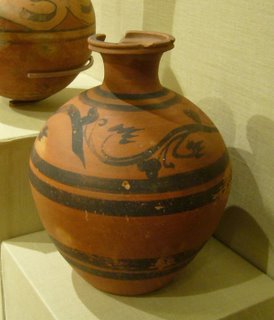 Not much for me from Nubia -- but isn't this pot rather elegant ?.
Not much for me from Nubia -- but isn't this pot rather elegant ?.
 Here's the star of the collection -- custom made for Sargon II c. 720 BC in his short-lived capitol of Khorsabad. There are several other monumental relief panels from that palace -- but it appears to me that the master sculptor himself worked on this one -- designing all the others, but leaving assistants to complete them. The drama -- the presence -- the magic -- this is what sculpture is all about.
Here's the star of the collection -- custom made for Sargon II c. 720 BC in his short-lived capitol of Khorsabad. There are several other monumental relief panels from that palace -- but it appears to me that the master sculptor himself worked on this one -- designing all the others, but leaving assistants to complete them. The drama -- the presence -- the magic -- this is what sculpture is all about.

 At the other end of the size scale -- come these one-inch
At the other end of the size scale -- come these one-inch
seals from Akkadia, c. 2200 BC. The carvers must have been fanatics to work those small, hard cylinders -- while designing the impression that they would leave when rolled over wet clay -- and their designs are ecstatic. This kind of work was done throughout the ancient middle east -- but everyone (who knows) knows that the Akkadians were the best.
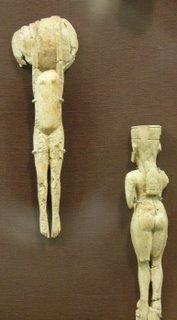 I can't figure these things out -- but these don't seem to be church-going girls -- expecially the one with the very pert bottom. And what fell on that other girl's head ? Who knows. (they're both from Palestine - c 1200 BC - Good-for-nothing Canaanites, no doubt. )
I can't figure these things out -- but these don't seem to be church-going girls -- expecially the one with the very pert bottom. And what fell on that other girl's head ? Who knows. (they're both from Palestine - c 1200 BC - Good-for-nothing Canaanites, no doubt. )
 But I think I know what this one is about.
But I think I know what this one is about.
(she comes from Luxor- the Roman period, 1st century AD)
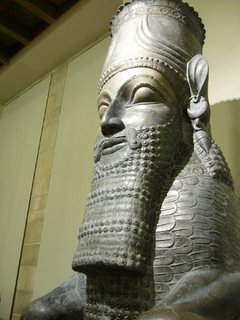
This is my favorite Persian sculpture in the museum -- back when Iranians were fun loving pagans. This piece feels a bit like a banquet table decoration, doesn't it ?
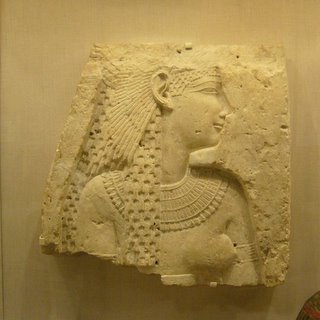 This goddess is very recent, as Egypt goes --
This goddess is very recent, as Egypt goes --
Ptolomaic period, 200 BC -- she's lost her seriousness, but not her sensuality.
 I forgot to record the origins of this one -- but I like sculpture of musicians --so here it is.
I forgot to record the origins of this one -- but I like sculpture of musicians --so here it is.
 I'm really attracted to this very ancient and very cute couple. They seem so eager to please. Wouldn't you like to have had them as parents ? They're Old Dynasty -- about 2400 BC from the tomb of Nenkefetka
I'm really attracted to this very ancient and very cute couple. They seem so eager to please. Wouldn't you like to have had them as parents ? They're Old Dynasty -- about 2400 BC from the tomb of Nenkefetka
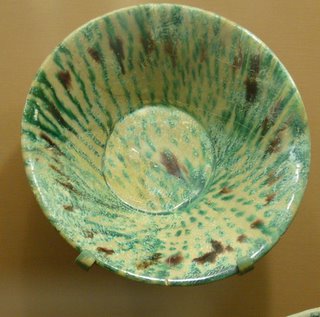 There were two Persian bowls from Istakhar -- so I'm guessing they're from 4th c. BC.-- and they are ecstatically beautiful -- as their design spins off into another world. This is the civilization that Alexander destroyed.
There were two Persian bowls from Istakhar -- so I'm guessing they're from 4th c. BC.-- and they are ecstatically beautiful -- as their design spins off into another world. This is the civilization that Alexander destroyed.
 This is a Cypriot 'bilbil' jug found in Palestine from about 1300 BC.
This is a Cypriot 'bilbil' jug found in Palestine from about 1300 BC.
Apparently it resembles the poppy flower, and residue in similar vessels tests positive for heroin derivatives. If only contemporary ceramics could be so sensual AND stately.
 Not much for me from Nubia -- but isn't this pot rather elegant ?.
Not much for me from Nubia -- but isn't this pot rather elegant ?.  Here's the star of the collection -- custom made for Sargon II c. 720 BC in his short-lived capitol of Khorsabad. There are several other monumental relief panels from that palace -- but it appears to me that the master sculptor himself worked on this one -- designing all the others, but leaving assistants to complete them. The drama -- the presence -- the magic -- this is what sculpture is all about.
Here's the star of the collection -- custom made for Sargon II c. 720 BC in his short-lived capitol of Khorsabad. There are several other monumental relief panels from that palace -- but it appears to me that the master sculptor himself worked on this one -- designing all the others, but leaving assistants to complete them. The drama -- the presence -- the magic -- this is what sculpture is all about. 
 At the other end of the size scale -- come these one-inch
At the other end of the size scale -- come these one-inchseals from Akkadia, c. 2200 BC. The carvers must have been fanatics to work those small, hard cylinders -- while designing the impression that they would leave when rolled over wet clay -- and their designs are ecstatic. This kind of work was done throughout the ancient middle east -- but everyone (who knows) knows that the Akkadians were the best.
 I can't figure these things out -- but these don't seem to be church-going girls -- expecially the one with the very pert bottom. And what fell on that other girl's head ? Who knows. (they're both from Palestine - c 1200 BC - Good-for-nothing Canaanites, no doubt. )
I can't figure these things out -- but these don't seem to be church-going girls -- expecially the one with the very pert bottom. And what fell on that other girl's head ? Who knows. (they're both from Palestine - c 1200 BC - Good-for-nothing Canaanites, no doubt. ) But I think I know what this one is about.
But I think I know what this one is about. (she comes from Luxor- the Roman period, 1st century AD)

This is my favorite Persian sculpture in the museum -- back when Iranians were fun loving pagans. This piece feels a bit like a banquet table decoration, doesn't it ?
 This goddess is very recent, as Egypt goes --
This goddess is very recent, as Egypt goes --Ptolomaic period, 200 BC -- she's lost her seriousness, but not her sensuality.
 I forgot to record the origins of this one -- but I like sculpture of musicians --so here it is.
I forgot to record the origins of this one -- but I like sculpture of musicians --so here it is.  I'm really attracted to this very ancient and very cute couple. They seem so eager to please. Wouldn't you like to have had them as parents ? They're Old Dynasty -- about 2400 BC from the tomb of Nenkefetka
I'm really attracted to this very ancient and very cute couple. They seem so eager to please. Wouldn't you like to have had them as parents ? They're Old Dynasty -- about 2400 BC from the tomb of Nenkefetka There were two Persian bowls from Istakhar -- so I'm guessing they're from 4th c. BC.-- and they are ecstatically beautiful -- as their design spins off into another world. This is the civilization that Alexander destroyed.
There were two Persian bowls from Istakhar -- so I'm guessing they're from 4th c. BC.-- and they are ecstatically beautiful -- as their design spins off into another world. This is the civilization that Alexander destroyed. This is a Cypriot 'bilbil' jug found in Palestine from about 1300 BC.
This is a Cypriot 'bilbil' jug found in Palestine from about 1300 BC.Apparently it resembles the poppy flower, and residue in similar vessels tests positive for heroin derivatives. If only contemporary ceramics could be so sensual AND stately.


0 Comments:
Post a Comment
<< Home